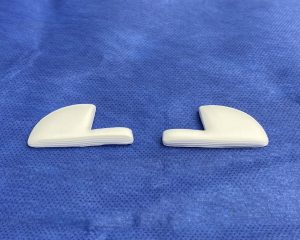One of the most aesthetic augmentations in the face due to a natural genetic shape is the midface in Asians. Lack of forward development of the nasal base (pyriform aperture) is common in such patients, and while paranasal augmentation was once reserved for an adjunctive procedure in rhinoplasty, it is now often done as a stand alone aesthetic procedure.


For design of paranasal implants, the lengths of both lower and lateral edge were measured for reference. In a regression analysis, the alar base-alveolar process angle was significantly associated with the degree of paranasal concavity.
In many paranasal deficiencies there is a difference between the projection of the alveolar process inferiorly and the side of the nose superiorly. This angular difference is what defines a paranasal deficiency when a Class III or edge to edge occlusion is not present. An implant design may need to consider providing augmentation of the nasal base out onto the maxilla. Whether this should be done by a standard or custom paranasal implant design can be debated.
Dr. Barry Eppley
World-Renowned Plastic Surgeon




